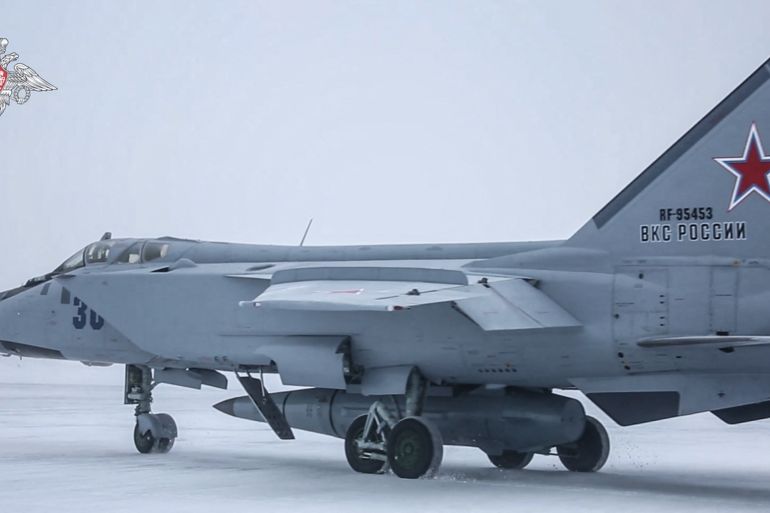Hypersonic missiles: Why is Russia using them in Ukraine?
Russia has become the first country to test this new type of missile, billed as ‘unstoppable’, in combat.

In the never-ending quest to find weapons that will give a country the power it needs to knock out its adversaries, a new type of weapon has emerged: ultra-fast ‘hypersonic’ missiles that can hit targets anywhere on Earth within an hour.
Using cutting edge technologies that have only just been perfected, these new weapons are billed as “unstoppable”.
Keep reading
list of 4 itemsRussia-Ukraine war: List of key events, day 791
Ukraine wins bipartisan US support, strikes Russia from afar
In Ukraine, low hopes for the liberation of lands occupied by Russia
Now Russia has said it launched its Kinzhal (Dagger) hypersonic missile at, among other targets, a weapons depot in western Ukraine – making it the first country to ever test this type of missile in combat.
So, what are these new types of missiles and why are they significant?
What are hypersonic weapons?
The word “hypersonic” means anything that moves at five times the speed of sound – 6,174 kilometres per hour (3,836mph) or more – in other words, extremely fast. Speed is important as it gives an opponent less warning and less time to react.
Most ballistic missiles already move this fast; what makes hypersonic missiles different is that they glide in the upper atmosphere and are highly manoeuvrable. Ballistic missiles, once launched, have very limited possibilities to alter their course, much like a ball once thrown.
These new missiles come in two forms; the first is hypersonic glide vehicles (HGVs), which leave the Earth’s atmosphere and then plunge back into it, gliding through the upper layers in a shallow, random series of curves and turners, intended to fool an enemy’s radar as to their intended target.
The other type is the hypersonic cruise missile (HCM) which, while not as fast, is designed to fly low but also at extremely high speeds, surprising the enemy and giving it very little time to react.
The technological challenges for both types are immense. Flying at these extreme speeds through the air, friction is a key challenge, with temperatures rising to 2,200 degrees Celsius (3,990 degrees Fahrenheit). To put this in context, titanium melts at 1,670C (3,040F). These missiles have to be shaped and built from highly advanced materials designed to withstand such extremes.
Communication is a problem for these high-value weapons as the intense heat builds up a cloud of super-charged particles around them called plasma, which is very hard for normal radio communications to penetrate. A similar problem exists for spacecraft on atmospheric re-entry and, in those moments, communications are usually blacked out.
Manoeuvrability at such high speeds, a key attribute of these weapons, places serious strain on the structure of the missile and early test models have literally torn themselves apart while attempting to steer a new path. All these challenges mean these new weapons have still not been fully developed as designers struggle to produce viable test models that can be made operational.
Despite all these challenges, the successful use of its Kinzhal hypersonic missile meant Russia became the first country to use one in combat. However, the question remains: why use a weapon this expensive when a traditional ballistic missile could do the job just as easily with less risk of failure?
Conflicts are used as testing grounds for new weapons under realistic conditions. Normal test data can be massaged but in combat, there is only success or failure. It is this kind of testing that is invaluable as successes can be leveraged and failures can be quickly fixed. Either way, expect these weapons systems to now be incorporated into the world’s arsenals.